
Red-cheeked squirrels are species of squirrels in the genus Dremomys in the subfamily Callosciurinae. The six species which are all found only in Asia are listed as "Least Concern" by the IUCN.

The family Fulgoridae is a large group of hemipteran insects, especially abundant and diverse in the tropics, containing over 125 genera worldwide. They are mostly of moderate to large size, many with a superficial resemblance to Lepidoptera due to their brilliant and varied coloration. Various genera and species are sometimes referred to as lanternflies or lanthorn flies, though they do not emit light.

The Indian roundleaf bat, also known as the large Ceylon leaf-nosed bat or Kelaart's leaf‐nosed bat is a species of bat in the family Hipposideridae. It is endemic to the Indian subcontinent, with marginal populations also detected in Southeast Asia. Its natural habitats are subtropical or tropical dry forests and caves. The bat has three subspecies that occur in India, Sri Lanka, and Myanmar. The Indian subspecies, H. l. indus, is smaller than the ones found in Sri Lanka and Myanmar, although there are no other characteristics that differentiate the subspecies.

The East Asian tailless leaf-nosed bat or tail-less leaf-nosed bat is a species of bat in the family Hipposideridae. It is found in Bangladesh, China, India, Indonesia, Laos, Malaysia, Myanmar, Taiwan, and Vietnam.
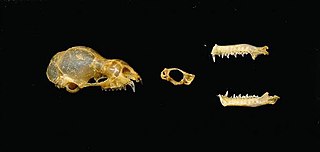
The ashy roundleaf bat is a species of bat in the family Hipposideridae found in Bhutan, Cambodia, India, Indonesia, Laos, Malaysia, Myanmar, Nepal, Pakistan, Thailand, and Vietnam.

Pyrops candelaria is a species of planthopper often placed in the tribe Laternariini. This species has been recorded from: Guangdong, Guangxi, Cambodia, Vietnam, Hong Kong, Laos, Thailand and other parts of southeast Asia. It is the type of the genus Pyrops erected by Spinola in 1839.

The fulgorid genus Fulgora contains several large Central and South American planthoppers known by a large variety of common names including lantern fly, peanut bug, peanut-headed lanternfly, alligator bug, machaca, and jequitiranaboia.

Pyrops is a genus of planthoppers that occur primarily in southeast Asia, containing about 70 species. They are fairly large insects, with much of the length due to an elongated, upcurving, snout-like projection of the head. The wings are generally brightly patterned in contrasting colors, and they are popular among collectors.
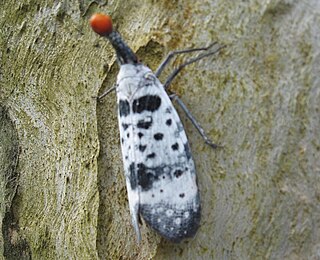
Pyrops clavatus is a species of true bug in the family Fulgoridae, in the genus Pyrops which are sometimes called "lanternflies". This species is found in parts of northern and northeastern India, Myanmar, northern Thailand, southern China and northern Vietnam. The tip of the elongated head capsule is spheroidal, shiny and chestnut in colour while the remainder of the process is black with fine white spotting. The forewing has a variable patterning of black, grey and white. The hindwing is purplish white with the apical half black. Specimens have been obtained along the Himalayas west to Mussoorie but more often in Assam, Sikkim, Shillong and the Khasi Hills.
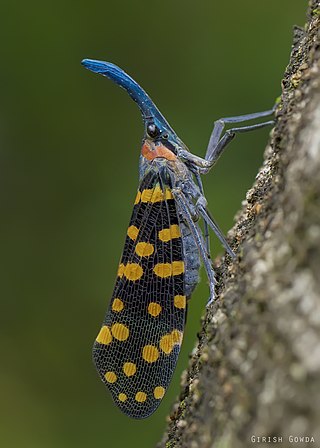
Pyrops delessertii is a species of true bug in the family Fulgoridae, in the genus Pyrops which are sometimes called "lanternflies". This species is found in the Nilgiris and Western Ghats of southern India. The head and "snout" or cephalic process is greenish. The thorax has a reddish colour and there are three spots on the mesonotum.

The grand roundleaf bat, also known as the grand leaf-nosed bat, is a species of bat in the genus Hipposideros. It can be found in China, Myanmar, Thailand, and Vietnam.

Shortridge's horseshoe bat is a species of Horseshoe bat native to Northeast India, northern Myanmar, and southern China. It was first described in 1918 by Knud Andersen, and was considered a subspecies of Blyth's horseshoe bat until 2003 when the two species were collected in sympatry.

The spotted lanternfly is a planthopper indigenous to parts of China and Vietnam. It has spread invasively to Japan, South Korea, and the United States. Its preferred host is tree of heaven, but it infests crops including soybean, grapes, stone fruits, and Malus spp. In its native habitat, L. delicatula populations are regulated by parasitic wasps.
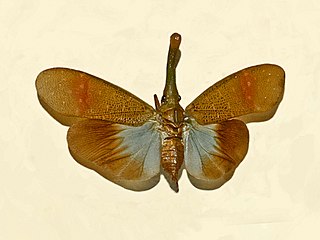
Pyrops pythicus is a species of true bug in the family Fulgoridae, in the genus Pyrops which are sometimes called lanternflies.
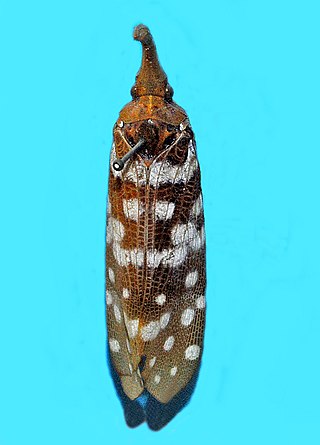
Pyrops maculatus is a species of planthopper belonging to the family Fulgoridae. A population is found in Sri Lanka while another is known from southwestern India.

The Fulgorinae are a sub-family of insects in the Auchenorrhyncha: which include the spectacular "lantern-bugs" and allied insects.

Lycorma imperialis is a planthopper indigenous to parts of China and Indo-Malaysia. L. imperialis was originally discovered in 1846 by Adam White and has one recognized non-nominate subspecies, L. i. punicea. L. imperialis has undergone a number of reclassifications since its discovery and is one of four species in the genus Lycorma. L. imperialis follows a hemimetabolous life cycle and will undergo a series of nymphal stages (instars) before maturing to an adult.
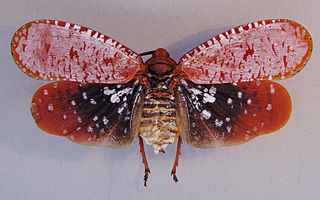
Aphaena submaculata is a species of planthoppers in the sub-family Aphaeninae of Fulgoridae. Various subspecies are distributed throughout the Indo-China region. The species was first observed by Frederick William Hope in 1840 and was formally described by James Duncan in 1843. Since then, it has undergone multiple reclassifications and now has 3 recognized subspecies which differ by color and/or length. The species feeds on tree sap via specialized mouthparts and follows a hemimetabolous life cycle.
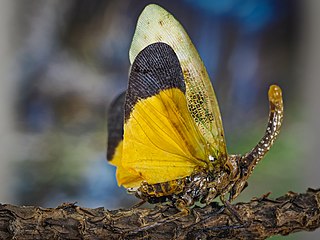
Pyrops lathburii is a species of lanternfly found in North India, Northern Thailand, South China, Laos, and Vietnam.
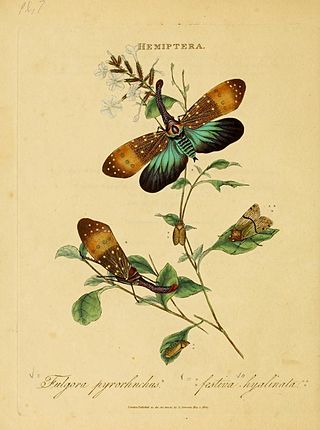
Pyrops pyrorhynchus is a species of lanternfly of the family Fulgoridae. It is found in India, Thailand, and Malaysia.


















